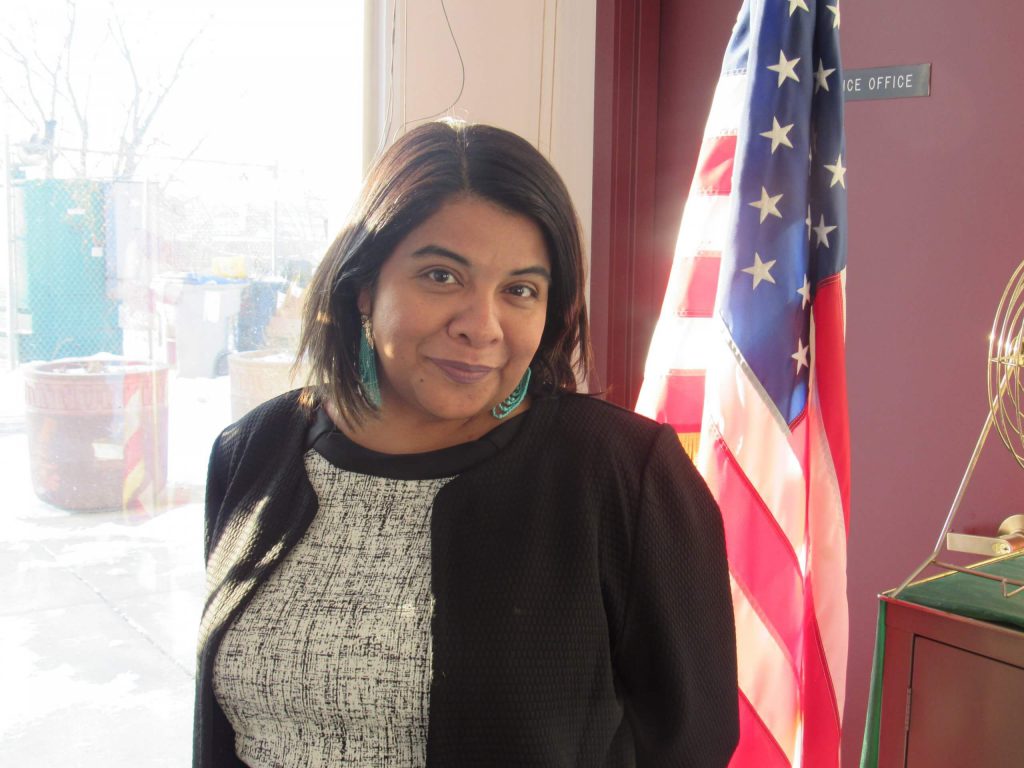Do Local Elections Avoid Certain Voters?
Emphasis on frequent voters can mean poorer and minority areas are avoided.
American electoral season is in full swing. You see it at the local and the federal level, from the Bloomberg ad blitz to modest hand-mailed reminders to register for your local primary. Often the intricacies — and the shortfalls — of the electoral system aren’t apparent to candidates until they’re thrown into it. That’s what Andrea Rodriguez realized, after beginning her run for Milwaukee County Supervisor in Dist. 4.
For local candidates, like Rodriguez, the first step is gathering enough signatures from potential voters in your district to get your name on the ballot. These are compiled, and then sent to local elections officials. Signatures are then counted and examined to see if the address associated with voters’ names are within the voting district. Signatures can be challenged for mistakes including addresses outside the district where potential voters are eligible to vote or illegible or missing printed names.
Candidates must balance the need to secure valid signatures with outreach. “A lot of the campaign managers who have helped me out,” explains Rodriguez, “they would give me ‘turfs,’ and they would say, ‘go to these areas.’” For Rodriguez, “these areas” were mostly in Bayview, with an 81.5% white population and 11% Hispanics. All other ethnic demographics in Bayview make up less than 2% of the population. But those aren’t the demographics for her entire district, significant portions of which are made up of poorer, renting, minority families.
The areas Rodriguez was instructed to canvass showed the candidate where the largest clusters of voters live. “In order to get an edge,” she told Wisconsin Examiner, “you look at certain parts of the map. You don’t just look at any registered voter.” Candidates do not, in fact, have to collect signatures of registered voters specifically. In order to sign nomination papers you need to be 18 years of age, live in the district, and be eligible to vote (meaning not currently under felony supervision), not registered to vote.
While targeting specific areas where you know you’ll connect with reliable voters is a good strategy, it seems to create a quiet domino effect that affects representation and connections throughout the district. This is especially damaging in a time when organizations and campaigns want to increase voter turnout, so Rodriguez wonders why there isn’t more voter education to engage more potential voters in all areas.
Her campaign needed 200-400 signatures to make it through the nomination process, which she ultimately did. “It was important to me that I did not turn in a list that did not have any black or brown voices on there whatsoever,” says Rodriguez. “So I went to certain houses in my neighborhood, even ones that were not necessarily on the turf map that I was given.”
“If we’re going to take taxpayer dollars from everyone,” she says, “we need to give them an opportunity to have their voice heard … and to sign a nomination form for someone in their own neighborhood, if they want to. And that hasn’t happened.”
Controversy surrounding Milwaukee’s spring primary brought the signature issue to the forefront. Two candidates were not put on the ballot for the county executive race after it was discovered that they had hired the same outside parties to collect their signatures. Under Wisconsin law, only the first candidate to submit signatures from one signature gatherer can have them counted. County Board Chairman Theodore Lipscomb Sr., who criticized the pair for their actions, also outsourced his signature gathering efforts. (He collected enough valid signatures to qualify to be on the ballot but did not survive the primary.) The incident raised questions in the mind of Milwaukee resident Yaghnam F. Yaghnam, who was also gathering signatures to run for county executive.
Using his route as a Milwaukee city bus driver to connect with people, Yaghnam was able to gather enough nomination signatures. Yaghnam tells Wisconsin Examiner that a Milwaukee County Election Commission representative “called me prior to counting my signatures to tell me they were counting my signatures. Two hours later I get a call, ‘we’re throwing out 89 of your signatures, so you’re not going to be on the ballot.’”
Yaghnam accepted the news, until he found out about the actions of Lipscomb and the two other county executive candidates. Echoing Rodriguez’s concerns, Yaghnam says his signatures were discarded because, “some of them weren’t right addresses, or they couldn’t read the names, or stuff like that.”
Yaghnam recounts collecting signatures from average people on the bus stop, in neighborhoods which aren’t necessarily on those high-voter turf lists in Milwaukee. “Most of mine were from actual people that met me,” he says. Yaghnam says his view behind the curtain of Milwaukee’s electoral politics and how it affects representation of the entire community “left a bad taste in my mouth.” He adds that it all seems tied to who knows who and how candidates are encouraged to connect — or not connect — with voters under the current system.
Paul Rasky, who ran unsuccessfully for mayor, losing in a four-way primary, believes that insider politics that dominate many local races exclude voices and necessitate political games, which “can make or break elections.” As he canvassed, Rasky met many people who didn’t know the primary was on Feb. 18. He says understanding the process “should be easier, there should be one place to go to, regardless of what language you’re speaking.”
Rodriguez met many people who thought, mistakenly, that they needed to go to the Department of Motor Vehicles (DMV) in order to update their information to vote. For renters and people who work all day for low wages, that can be a very unattractive, time-consuming prospect. “Talking to residents here, especially because we don’t have a Social Security office anymore on the south side, they’re having to go all the way downtown to do a lot of things for themselves. And it is a difficulty.”
Voters who have changed addresses need to re-register to vote. They can do that online at myvote.wi.gov or at the poll on Election Day with a proof of residence document.
Perhaps, she speculates, that’s partly by design. “There has been much evidence of voter suppression,” says Rodriguez, “there has been gerrymandering. We have cuts to our education all the time. And I know as a classroom teacher, we are literally taking away individuals’ tools to learn anything [when you are] young, and as you get older, it does not get easier.” She feels parts of certain zip codes get ignored because, “as soon as you’re born here, the odds are stacked against you in order to get information. And we’re in the information age.”
Jason Auerbach, who is running for alderman in Dist. 14, says he has also noticed how the system can be unhelpful for voters. “If you’re updating your drivers license, or updating other sorts of data, it should just automatically update your voter registration. You shouldn’t have to be going multiple places to be updating your addresses.” Though Auerbach understands why the system functions the way it does, he adds, “I think it should be easier for a lot of people.” Whether it’s picking kids up from school or long hours at work, he says people already are juggling a lot. “There should be less barriers,” he says.
When Rodriguez asked the Wisconsin Elections Commission officials how to inform residents about the signature process, she was told that voter-oriented materials explaining their role in the nomination paper process didn’t exist. The answer she got is that it’s left up to individual campaigns and third-party groups how to canvass and how they’d like to explain the nomination process to potential constituents.
Wisconsin Examiner asked the Wisconsin Elections Commission who is responsible for informing voters about how to participate in the process.
Candidates who fail to capture full signature pages when they photocopy them is a frequent problem, Magney says. There is a training on common reasons for nomination paper challenges, including incorrect names and dates, on the Elections Commission’s website.
“Its very technical,” says Magney. “I understand why someone running for office for the first time would make mistakes.”
But the lack of available information can be — and sometimes is — wielded as a strategic weapon by potential opponents.
“I’ve been at political trainings where … they simply tell you that the best way to beat a candidate is not have them appear on the ballot,” says Auerbach. “So there’s literally incentive for people to make sure you’re not on the ballot. Especially for someone like me, I don’t come from politics.” He says it’s a sobering reality, particularly when, “you’re running against more hardened politicians or more political machinery, people who know how to navigate the system, because it is a complex system of rules and laws.”
Rasky says he felt that kind of heat during the mayoral nomination process, and it held him back. “I didn’t want to step on too many toes,” he told Wisconsin Examiner.
To a certain extent, the state Elections Commission agrees. “It would be wonderful if voters knew about all the ins and outs of signing nomination papers,” says Magney, “and knew how to look for potential flaws in how the candidates have filled out the header and footer information that might cause those papers to be struck if there’s a challenge. But this is highly technical information that is better suited to be directed at candidates and their campaign workers.”
“The issue is not the acceptance of signatures,” says Rodriguez. Rather, she says, the problem is with candidate training, and the way candidates are trained to use the Democratic Party’s voter-contact software when they go out to gather signatures and launch their campaigns. “From day one of candidate trainings, the State Voices VAN app is pushed as a necessary tool for a real campaign,” Rodriguez says. “The VAN focuses only on registered voters and many of the areas candidates are directed to for collecting signatures are not typically diverse wards.” She says, “when residents are asking for more diverse leaders, it’s important to clarify every aspect of the process so we can make diverse representation a reality.”
At the end of the day, the effects of the system on representation can be corrosive. When entire blocks or neighborhoods don’t see public representatives unless it’s campaign season, it only adds to the cynicism.
“Here’s what I hear a lot,” says Rodriguez, commenting on her time canvassing residents in her district. “No one knocks on my door, and if they do it’s ‘cause they want something.”
“Elected officials, when they’re doing their play, it’s always, ‘You know what? These are the houses you go to. These houses you might not even get signatures, it’s not worth your time.”
If people are going to get the representation they deserve, she says, that has to change.
Correction: An earlier version of this piece mistakenly stated that local officials need to submit nomination signatures to the Wisconsin Elections Commission. In fact, local candidates submit nomination papers to local elections officials. A candidate quoted in this piece also mistakenly asserted that voters must have their voting addresses updated in order for their nomination signatures to be valid. In fact, as the updated version of this story explains, anyone can sign nomination papers who is at least 18 years of age, eligible to vote, and living in the district the nominated candidate is running to represent. The Examiner regrets these errors.
Reprinted with permission of Wisconsin Examiner.
Political Contributions Tracker
Displaying political contributions between people mentioned in this story. Learn more.






















